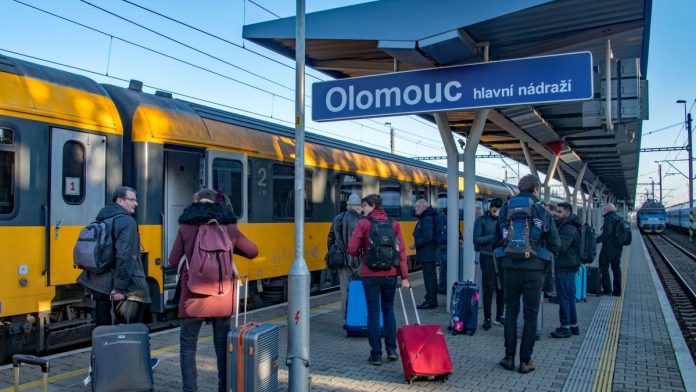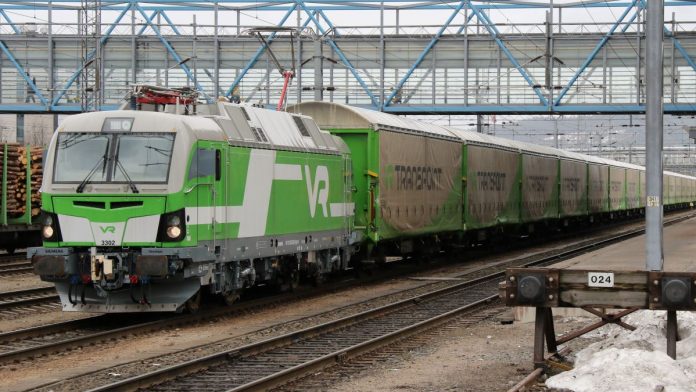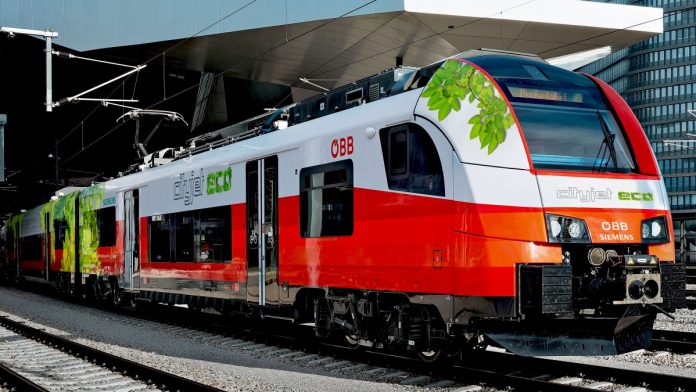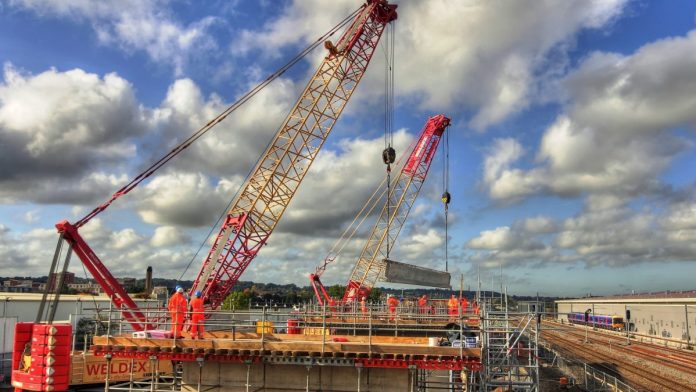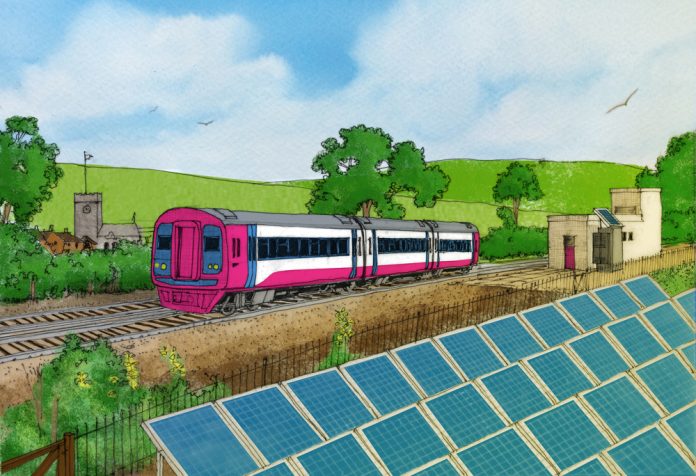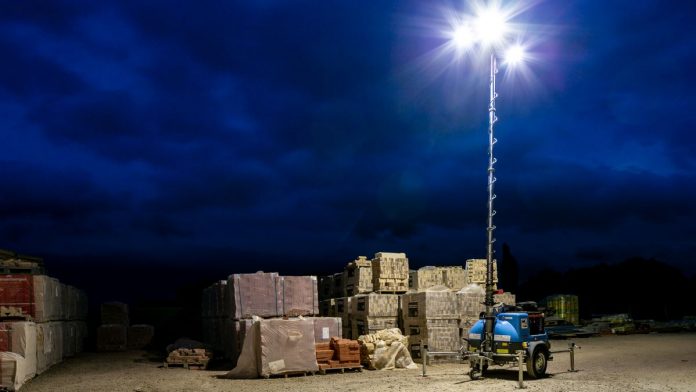It is easy to sympathise with teachers who take groups of schoolchildren on educational visits, as they work hard to keep their charges together. Consider, then, the task of Felix Schmid and Bridget Eickhoff as they led a group of 40 railway engineers (and their luggage) from the Czech Republic to Switzerland via Austria. This took a week and involved 14 technical visits, four hotels, a sleeper train, travel on 24 other trains and 12 trams. The average start time was 07:45.
This was the IMechE Railway Division’s Annual Technical Tour, one which Felix and Bridget had spent months organising. For everyone on the tour, it was huge learning experience to see the manufacture, maintenance and operation of trains and trams, as well as learning from each other. The opportunity to have informal chats with senior engineers was particularly useful for the young engineers, some of whom contributed to this article.
In addition to the engineering experience, the group had to hone its time management, organisational and packing skills to keep up with the demanding schedule. The tour also provided an opportunity to visit cities that many of the group had never heard of.
Participants had made their own way to Prague where the tour started at 13:00 on Saturday 5 October with a short tram ride to a train maintenance depot.
České dráhy
In the Czech Republic, infrastructure maintenance is undertaken by the state infrastructure manager, SZDC whilst České dráhy (CD) is the state railway operator, although there are also some private operators. The Czech rail network is about two thirds the size of the UK’s railway and 31 per cent of it is electrified. Overhead electrification is a mix of 3kV DC in the north and 25kV AC in the south. There is a 20-year plan to convert the 3kV DC lines to 25kV AC.

The visit was CD’s Prague maintenance centre, which is responsible for 90 EMUs, 247 DMUs, 75 diesel locomotives, 113 electric locomotives and 1,082 coaches. The EMUs include the Czech Pendolinos and the double decker “City Elefant” EMUs. CD has two other maintenance centres, at Pilsen in the west and Olomouc in the south.
At the Prague maintenance centre, which has 40 kilometres of track, the group visited its two maintenance sheds and saw loco-hauled coaches being maintained in one and Elefant EMUs in the other, where a wheel lathe had been installed a year ago. To make the best use of this lathe, CD is about to procure a wheelset preventative monitoring system.
Prague’s trams
Sunday offered sightseeing with a purpose. The funicular ride up the hill to Prague’s Petřin Tower viewpoint showed why this type of railway needs wheelsets with one double flanged wheel (to run on the continuous outside rail) and the other with no flanges (to cross breaks for cables in its fixed switches).

In the afternoon, the group visited the Prague public transport museum. This had many tram vehicles, illustrating the expansion of the city’s substantial tram system, which started in 1875 with the first horse drawn tram and had its first electric tram operating in 1891. Prague’s tram network now covers 141 kilometres with 35 lines.
The numerous trams, and other artefacts, in the museum showed how these vehicles had developed. They included a motor tramcar dating from 1901 and specialist vehicles such as a substation car, which had a transformer and rotary converter so that it could be connected to an AC substation to boost the overhead supply when required, such as during major sporting events.
The tour left the museum on the 1915-built tram 349 and its trailer car for a tour of the Prague tram system. Our driver, Helga, demonstrated the hard work and skill that is required to drive such historic trams.

Škoda
Monday started with a train ride to Pilsen to visit Škoda’s rolling stock plant on which Emma Armstrong, a graduate engineer from ScotRail, reports:
Continuing Škoda’s long tradition at Pilsen, Škoda Transportation has been manufacturing rolling stock here since the 1990s, particularly electric rail vehicles for suburban transport. The site runs an end-to-end process in the production of tram and locomotive vehicles, with EMU and carriages being manufactured at other sites throughout the Czech Republic. There is also a subsidiary company in Finland – Transtech Oy.
The factory consists of several sheds used in the building of coaches, refurbishment of vehicles and overhaul of bogies. The tour was limited to the assembly halls, paint shed and testing track. On display were vehicles at varying stages of assembly or overhaul including the Emil Zatopek locomotive (named after the famous Czech long-distance runner) and driving coaches from double-decker EMUs that are supplied to Deutsche Bahn and are capable of a top speed of 189km/h.
Interestingly, only electric traction vehicles are currently produced at this site. Although Škoda can produce diesel hybrid vehicles, customer demand remains focused on electric vehicles.
The current rolling stock manufacturing process begins with the welding of the initial body shell which is then transported through the plant for low-level equipment fitment, interior cabling and high-level fitment such as HVAC (heating/ventilation/air-conditioning) and pantograph assemblies. Škoda uses a 36-metre covered traverser to move vehicles during manufacturing.
Completed vehicles are initially tested using a short on-site test track. For more intense testing, the heavy rail rolling stock is sent to the Velim test track at Cerhenice, 150km away to the east.
Škoda manufactures almost all the required components, either at this site or other locations, to enable them to produce a fully Škoda product.
From Plzen, it was a 1¼-hour train ride back to Prague, then another 2½-hour train journey to Olomouc, in the southeastern part of the Czech Republic.

Olomouc’s unusual crossing
Tuesday saw the tour in the city of Olomouc, where the group split into two. One party visited the OLTIS group headquarters to see its IT solutions for railway performance and operational management. The other group visited an unusual level crossing, as Nadeem Ahmed, a Network Rail graduate electrical engineer, reports:
In 2013, an extension to one of Olomouc’s tram lines crossed a single-track railway that catered for 28 trains per day. The resultant tram/train crossing was designed so that the tram wheel flanges run across the head of the heavy rail. As it does so, the tram wheel is not constrained. However, as the crossing is angled at 60 degrees, the other tram wheel is in the tram track.
The Olomouc council funded and built the level crossing over six months. The formation of the crossing began with a geo cell layer, with additional layers consisting of sand, concrete and steel meshes to provide enough strength to withstand the various loads. Trains go over this crossing at 80km/h, whilst trams cross it at 10 km/h.
Afterwards, the group visited the Olomouc’s public transport control centre to learn how timekeeping of trams and buses is monitored and controlled. Olomouc has a 31-kilometre tram network with 75 switches, two thirds of which have switch heaters as winter temperatures are typically -10°C. The city has 71 trams and 59 buses.
Brno’s trams
A 1½-hour train ride took the group to Brno, the Czech Republic’s second city with a population of about 400,000. Brno has a 70-kilometre tram network on which a fleet of 300 trams operate. It also has a 60-kilometre trolley bus network, with 140 trolley buses, and 46 bus routes. Ten trolley buses with batteries are being procured to allow for network disruption during road works.
Another chartered tram took the group to the main depot, with a stop to examine a newly installed 80km/h switch. For trams, this is a high-speed switch as the normal speed through street switches is 15km/h on the straight and 10km/h on the curve.

At the depot, the systems used to monitor the timekeeping of each vehicle were explained, as were the ways in which passengers are kept informed. Five buses and four trams are kept on standby around the city, ready to be quickly brought into service in the event of any disruption.
The control room also closely monitors power consumption, with drivers receiving bonuses for low electricity use. Interestingly, control can temporarily switch off the heating on trolley buses and trams remotely if overall power consumption is too high.
During the depot tour, there was an opportunity to examine old and new tram bogies. Notable were the large braking solenoids on the trailer bogies, which are needed as the trams have no air system.
A second 1½-hour train journey took the group from Brno to Vienna.
Wiener Linien

Vienna’s public transport system consists of a 29-line tram network of 181 kilometres, five U-Bahn lines totalling 65 kilometres and 43 daytime bus routes. It is operated by Wiener Linien, which has 526 trams, of which 168 have low floors. The tour visited the main workshops in Vienna, which undertakes tram heavy maintenance and component repairs, including bogies, traction motors, wheelsets and brake gear.
Of particular interest was the opportunity to inspect the unusual suspension and drive system of the ultra-low-floor trams supplied by Siemens between 2006 and 2015. These consist of a series of vehicle modules with portal running gear in between. There is a rigid connection between the driving cab module and the adjacent module, between which is the portal gear with single trailing wheels. Other modules are supported at one end by the portal gear through the secondary suspension and flexibly coupled to the next one. These portals have 52kW asynchronous traction motors driving each single wheel.
These trams are 36 metres long, which presents a problem as the workshop traverser, constrained by the workshop’s columns, is only 30 metres long. For this reason, the traverser is about as wide as it is long to accommodate trams on its curved track.
Traktionssysteme Austria
The group’s next call in Vienna was to the manufacturing plant of Traktionssysteme Austria (TSA) as Franziska Schmuecker, a project engineer for Eversholt Rail, reports:
TSA is an independent manufacturer of traction motors and gearboxes for rolling stock and road vehicles. The company’s values – “Innovative. Independent. Impassioned.” – were clear from the start of the visit, which was split in two parts: a series of presentations on the history of the company and its products (including UK products such as those for the new Glasgow Subway trains) followed by a tour of the production facilities.
The first technical presentation outlined the different traction motor cooling concepts used by TSA, which included self-ventilation, forced ventilation, liquid cooling and air cooling. Motors can be either an enclosed design or an open design using fresh air to cool the motor. Another presentation explained the advantages and disadvantages of different motor suspension arrangements.
One presentation explained the latest permanent-magnet traction motors, which provide a superior power output (up to 67 per cent increase) and torque (48 per cent increase) for the same motor size. Where size and weight are constraining factors, this is a great advantage.
As with all innovations, there are challenges to overcome, mainly controlling the induced voltage at higher speeds, which leads to the need for a separate traction inverter to control each motor. From all the presentations, it was clear that TSA is highly flexible in the projects and types of motor it delivers.
The presentations were followed by a tour through the production facilities, following the manufacturing process from the stamping of the rotor and stator laminations to the finished motor. Almost everything, except for the production of the standard coils, is done in-house, including the testing of the finished motor. TSA produces around 6,000 motors per year in this facility.
Producing yellow plant
Thursday started with a 200-kilometre train ride, at up to 250km/h, on the upgraded Austrian West Railway to Linz. Here, the tour visited a well-known manufacturer of yellow plant as Calum McLean, an assistant electrical project engineer with Network Rail describes:
Plasser and Theurer manufactures a major proportion of the world’s track maintenance machines. The range includes tampers, for which the company is perhaps best known, as well as machines for ballast management, stabilisation and control, ballast bed cleaning, formation rehabilitation, material logistics, the renewal and laying of tracks and turnouts, mobile rail treatment and the measurement, installation and maintenance of overhead lines.
If a customer’s requirements are not fulfilled by the standard range, special purpose machines can be manufactured as well. In any case, all machines are custom built to individual customer requirements and training is provided at the Linz plant for each machine.
It is not necessary to be a track engineer to appreciate how these machines have revolutionised track renewals and maintenance. For example, Plasser and Theurer advises that its machines can renew 2.6km of track per hour, compared with a 100 metres of track per hour when such machines were not available.
It was impressive to see the work that goes into manufacturing these machines, particularly as the company manufactures nearly all its own parts to ensure product quality. Every year, the Linz site produces around 150 machines of varying types with a workforce of 1,800. Despite this apparent complexity, bogie production has been standardised – there are only two basic types of bogies for all types of machine, albeit with varying track gauges.
Linzer Linien
Unlike other trams seen on the tour, those in Linz are 900 mm gauge. The city has a five-line, 61-kilometre tram network with 62 trams. 56 of these are low-flow single ended trams built by Bombardier, including Cityrunner trams, supplied from 2002, and Flexity Outlook 2, delivered from 2011. There are also four double ended Flexity Outlook trams with modifications for steep gradients as well as three 1974 trams that were rebuilt in 2010 with new running gear which are also suitable for steep gradients.
After a depot tour, the group boarded one of the rebuilt 1974 trams for a ride to the Pöstlingbergbahn museum, which explains the history of one of the world’s steepest adhesion railways. This opened in 1898 and climbs 255 metres in 2.9 kilometres, with a maximum gradient of 11.8 per cent (1 in 8.5). After seeing the museum, the tram took the group to the top of the Pöstlingberg, a hill overlooking the Danube valley.
From Linz, the group travelled overnight to Switzerland on cramped double-decker sleepers.
Stadler
After the sleeper arrived at Buch early on Friday, a local train and bus took the group to the site of a former seaplane factory on Lake Constance that is now Stadler’s manufacturing plant. Abigail Carson, a consultant engineer for Ricardo Rail, reports on the tour’s visit to this facility which, for her, was the highlight of the tour:
What impresses about Stadler is its lean production and how it achieves mass production combined with tailor-made solutions. The variety of rolling stock Stadler produces is impressive, from locomotives bound for California, Merseyrail’s new trains, double-decker KISS trains and compact Glasgow Subway trains – all with completely different body structures and sizes with vastly different design requirements.
Walking through the facility, it was interesting to see how the mass-produced, bare aluminium sections were transformed into such widely differing trains. It was clear that Stadler is growing and expanding with ease, supplying rolling stock globally.
The production layout is simple, logical, and easily adaptable. Each step of the manufacturing process is lean and efficiently timed. There is a coherent system, with a well-disciplined workforce and robust processes. The entire facility is spotless and has an almost clinical feel.
It was interesting to learn how Stadler utilises its expensive machinery by overlapping shifts. However, there are noise challenges associated with the surrounding villages, so sequencing the processes for the time of day is vital.
Appenzeller Bahnen
The remainder of the tour was spent in the rolling hills of eastern Switzerland, where train services are provided by Appenzeller Bahnen. Friday afternoon was spent experiencing the company’s two rack railways. The first, from Rheineck, by Lake Constance, was the 1.9-kilometre rack railway to Walzenhausen, which climbs 272 metres at a maximum gradient of 25 per cent.
From here, the group, and its luggage, just fitted onto a PostBus for a 20-minute ride to Heiden, which is 794 metres above sea level and the upper terminus of the 7.2-kilometre rack railway that descends 396 metres to Rorschach at a maximum gradient of nine per cent. The rack railway depot at Heiden, which was commissioning double-deck buses made in Scotland for the Swiss PostBus system, provided an insight into rack railway traction and braking systems. An examination of one of the motor bogies showed its braking system and the complex drive that enables the trains to be driven by either their rack or rail wheels.

The future of both these rack railways is currently being assessed, as they only cover about 30 per cent of their operating costs. Options under consideration include closure, automatic operation or, for the Heiden railway, which only has an hourly service, investment in extra capacity to generate extra revenue.
Whilst there is some doubt about the future of the Appenzeller Bahnen’s two rack railways, Saturday’s tour revealed the significant recent investment in its one-metre gauge adhesion railways. At St Gallen, the party’s train went through a 705-metre tunnel, opened in October last year, to replace a steeply graded part of the route that was a rack railway. This enabled a 15-minute service frequency to be introduced.
From St Gallen to the depot at Gais, the group travelled on a Stadler-built ‘Tango’ low-floor light-rail vehicle, which was one of eleven such trains delivered last year at a total cost of £66 million. These 53-metre-long units consist of two sets of three modules. The centre module of each set is mounted on a bogie and supports the adjacent modules, which each have only one bogie. This gives the six-module unit six bogies in a configuration that is designed for the sharp 30-metre radius curves on the route, which has a maximum gradient of eight per cent.
At Gais, there was an opportunity for a detailed examination of these units, together with the larger, 59-metre-long ‘Walzer’ low-floor EMU, five of which were also delivered last year at a cost of £31 million. The group travelled on one of these units from Appenzell to Gossau, to change onto the Swiss equivalent of a Pendolino (RABDe 500 jointly developed by Bombardier and Alstom) to Zurich and the end of the tour.
Shared learning
After seven intense days, it was clear that everyone had learned much from the visits and from each other. The 14 visits were a rare opportunity to study heavy and light rail maintenance and production outside the UK. The young engineers on the tour commented that they particularly appreciated the opportunity to see rail vehicle manufacturing at Škoda, Stadler and Plasser & Theurer, as well as the traction motor production at Traktionssysteme Austria.
Close scrutiny of the tram systems in Prague, Olomouc, Brno, Vienna and Linz showed the differences between main line and light rail practice. Many commented on the portal suspension of Vienna’s ultra low floor trams, Olomouc’s tram train crossing and the wide variety of tram bogies seen. The tour also highlighted the lack of light rail systems in the UK. Brno, for example, has a 70-kilometre tram network and is the same size as tram-free Leicester.
The way that Apenzellerland railways overcome the challenges of the Swiss terrain was also impressive and thought provoking. Indeed, one senior group of engineers debated the workings of rack and pinion traction well into the night. Although it was unclear whether the new Tango units were trains or trams, they are perfectly adapted to their sharply curved, one-metre gauge track with impressive acceleration up an eight per cent grade.
As one younger member of the tour put it, “we can learn so much from how things are done in different countries”. Providing such an opportunity was just one reason why the Railway Division’s Annual Technical Tour is such a worthwhile event.
Participants in the IMechE Technical Tour would like to thank Felix Schmid and Bridget Eickhoff, who organised and led the tour, all the group’s hosts in the Czech Republic, Austria and Switzerland, the event’s sponsors: Angel Trains, Beeston Rail Standards, Birmingham University Alumni, Eversholt Rail, Malcolm Dobell Consulting Ltd, Manchester Engineering Consultancy and Unipart Rail. Thanks also to Emma Armstrong, Nadeem Ahmed, Franziska Schmuecker, Calum McLean and Abigail Carson for their contributions to this feature.
—


